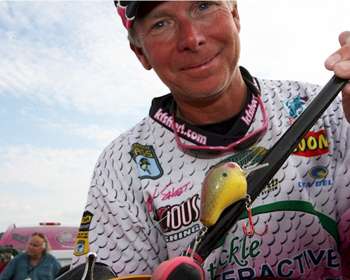
There are certain times and situations when a square-billed crankbait will outperform any other tool in the tacklebox. The key to properly fishing the hard-bodied bait lies in the art of deflection — how well you can bounce the bait off of rocks, limbs, or other shallow-water debris to garner a reaction strike from an otherwise uninterested bass.
To Elite Series pro Kevin Short, the square-billed crankbait and its deftness at deflecting off cover was the difference maker in his $100,000 win at Fort Madison's Genuity River Rumble last year on the Bassmaster Elite Series. Short points out, however, that there's more involved to making the bait work than just casting and winding.
"When you're retrieving it around objects — anything from a laydown to a stump — you have to understand that hitting the target with your bait is extremely critical," he says. "The whole key to fishing a square bill up shallow is to trigger a reaction bite, and about the only way to do that is to have the bait bouncing off something."
The purpose of the square bill — particularly when the weather and water are hot — is to coax a lethargic bass from hiding. This is something, he points out, that even a properly placed jig will fail to do in extreme cases.
"When the water's really hot, bass are not going to be aggressive," he says. "They're going to be tucked back into the thickest cover imaginable, so you've got to put the bait right in their faces, and then make it do something erratic to get an animalistic response out of the fish. I can't stress it enough — you've got to put the bait in their faces."
Short points out that many weekend anglers don't have the confidence to attack a target repeatedly in order to get the needed bite. "You might not get the fish to react the first time," he explains. "In fact, you might have to make eight or 10 casts to the same target in order to get that fish to bite. You have to trust your instincts.
"It's very important that you're using a bait that you can throw in that situation without getting hung up or, at the least, if you do get hung up, a bait that's pretty easy to get un-hung. The simple fact is, when you're fishing heavy cover for a reaction bite you're going to get hung up."
There's little science to the square-billed crankbait, Short concedes. The bait's simplicity, combined with an angler's ability to properly place and retrieve it, is what makes it seem near magical at times.
"The squared edge of the bill makes the bait stand on its nose," Short says. "That angle allows the hooks to stay away from the cover. Once you understand what the bait is capable of doing, you can actually 'walk' it down a log and bump every limb along the way. That's what you're wanting — as many deflections as possible to get that fish to react."
Establishing the right angle in which to line up your casts is something that can't be overlooked, but, as Short points out, eliciting a reaction bite consistently will require some time. "It might be a speed thing where you really have to burn it through the cover and kill it as soon as it hits a piece of cover," he says. "I can guarantee you that it won't be the same thing from one day to the next, and it can change from hour to hour. You're going to have to spend some time on the water to develop a feel for how the bass want the bait presented."
Short says that time on the water and practice with the square bill will enhance your abilities in the art of deflection.
"Really, you have to experiment with your baits to really understand how they will deflect," he says. "Once you're on the water you will have to experiment some more to determine how the fish want the bait."




